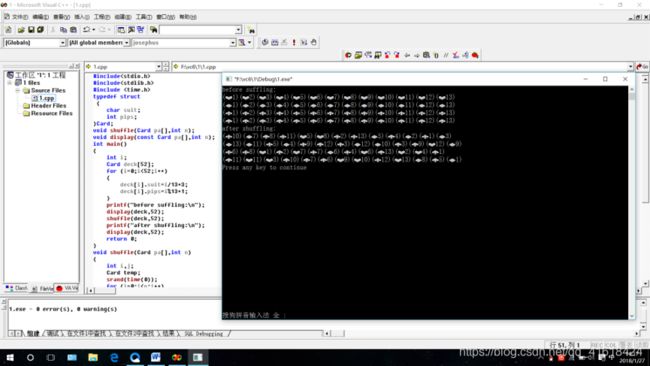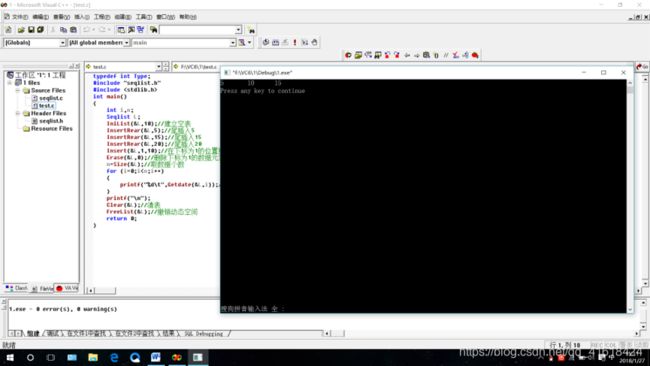C语言学习与感悟——《C语言学习基础程序》
前言
博主在几年前的C语言后中,结合自身学习情况和学习感悟在当时的一个寒假做了两份C语言学习的经验总结,分别为 《C语言学习基本框架》 和 《C语言学习基础程序》,
现在把它们分享出来,供大家交流学习,如果能给初学C语言的小伙伴们提供一些帮助也是不错的,想当初我也是从C语言的折磨中走出来的,吼吼吼!
一、常见练习题
1. 计算1!+2!+n!
思路:运用两层for循环,一层进行阶乘计算,一层进行加法运算.
#include
int main()
{
int n,i,j,k=1,s=0;
printf("请输入项数:\n");
scanf("%d",&n);
for(i=1;i<=n;i++)
{
k=1;
for(j=1;j<=i;j++)
{
k=k*j;
}
s=s+k;
}
printf("结果=%d\n",s);
return 0; }
2. 计算斐波那列数列第n项
思路:先对项数进行判断,分为两部分计算,第二部分运用递归的思想.
#include
int main()
{
int n,i,f,f1=1,f2=1;
printf("请输入项数:\n");
scanf("%d",&n);
if(n<=2)
f=1;
else
for(i=3;i<=n;i++)
{
f=f1+f2;
f1=f2;
f2=f;
}
printf("结果=%d\n",f);
return 0;
}
3. 爱因斯坦阶梯问题
思路:通过while循环判断,不断增加倍数,直至循环结束.
#include
int main()
{
int x=7,i=1;
while(!((x%2==1)&&(x%3==2)&&(x%5==4)&&(x%6==5)))
{
i++;
x=7*i;
}
printf("%d\t",x);
return 0;
}
4. 求勾股数
思路:通过三层for循环依次递增,再运用if语句进行判断.
#include
int main()
{
int x,y,z,k=0;
for(x=1;x<100;x++)
{
for(y=1;y<100;y++)
{
for(z=1;z<100;z++)
{
if(x*x+y*y==z*z&&x<y&&y<z)< p=""></y&&y<z)<>
printf("x=%dy=%dz=%d\n",x,y,z),k++;
}
}
}
printf("%d\n",k);
return 0;
}
5. 百钱百鸡问题
思路:通过三层for循环将鸡翁,鸡母,鸡雏依次递增,在运用if语句进行两个条件合并判断.
#include
int main()
{
int x,y,z;
for(x=1;x<=20;x++)
{
for(y=1;y<=33;y++)
{
for(z=1;z<=100;z++)
{
if(15*x+9*y+z==300&&x+y+z==100)
printf("公鸡:%d母鸡:%d鸡雏:%d\n",x,y,z);
}
}
}
return 0;
}
6. 编写函数,一趟循环,找出数组的最大元素和最小元素
思路:以a[0]为比较元素,与数组其他元素依次判断,如果大于则记录max,如果小于则记录min.
#include7. 编写函数,倒排数组元素
思路:将数组元素分为前后两个部分,然后两个部分头尾对应函数依次交换. 解法:
#include 8. 编写函数,从数组元素中挑选出百位数比十位数和个位数之和还大的元素
思路:将数组元素个位数,十位数,百位数分别赋值,后运用if语句比较判断. 解法
#include9. 编写检验密码函数,密码输入错误时,允许重新输入,最多3次
思路:首先运行for语句设置3次循环,进入for循环后首先进行strcmp判断,若为是则通过,不是则记录次数,达到3次则退出.
#include二、常见问题
1. Josephus问题
问题描述:假设有n个人围坐一圈,现在要求从第k个人开始报数,报到第m个数的人退出。然后从下一个人开始继续报数并按照同样的规则退出,直至所有人都退出。按照顺序输出各出列人的编号
#include2. 模拟洗牌
问题模拟:编程用C语言模拟人工洗牌过程
#include3. 起泡排序
问题描述:编程用起泡排序给一组数组从小到大进行排序
#include 4. 顺序表练习
问题描述:编程使用顺序表对数组进行一些基本操作
//Test.c(主函数)
typedef int Type;
#include "seqlist.h"
#include //Seqlist.h(顺序表声明)
typedef int Type;
#include //Seqlist.c(顺序表实现)
#include 5. 链表练习
问题描述:编程使用链表对数组进行一些基本操作
//Test.c(主函数)
typedef int Type;
#include//Node.h(结点声明)
#ifndef NODE_H
#define NODE_H
typedef int Type;
struct Node
{
Type date;
struct Node *prev;
struct Node *next;
};
typedef struct Node Node;
Node *Get_node(Type item,Node *prev0,Node *next0);
Type Get_date(Node *current);
Node *Get_next(Node *current);
Node *Get_prev(Node *current);
void Set_date(Node *current,Type item);
#endif
//Node.c(结点实现)
#include"Node.h"
#include//List.h(链表声明)
#ifndef LIST_H
#define LIST_H
#include"Node.h"
typedef struct
{
Node *head;
Node *tail;
int size;
}List;
void Init(List *L);
Node *Begin(List *L);
Node *End(List *L);
Node *Insert(List *L,Node *current,Type item);
Node *Erase(List *L,Node *current);
Type *Front_pointer(List *L);
Type Front_date(List *L);
Type *Back_pointer(List *L);
Type Back_date(List *L);
void Push_front(List *L,Type item);
void Push_back(List *L,Type item);
void Pop_front(List *L);
void Pop_back(List *L);
int Empty(List *L);
void Clear(List *L);
void Free(List *L);
#endif
//List.c(链表实现)
#include"List.h"
#include结语
《C语言学习基础程序》仅为博主在学习C语言时自己的记录与积累,加上后期的整理所成。可能对于C语言入门的理解与初步掌握有一定的帮助。
当然,介于当时的水平有限,文章本身可能还存在内容上的纰漏或者错误,如果读者在阅读中发现错误,也请不吝指出,谢谢!
注:《C语言学习基础程序》会放在附件中,感兴趣的小伙伴欢迎下载嗷~
下载链接: C语言学习基础程序——Mr.鹏




